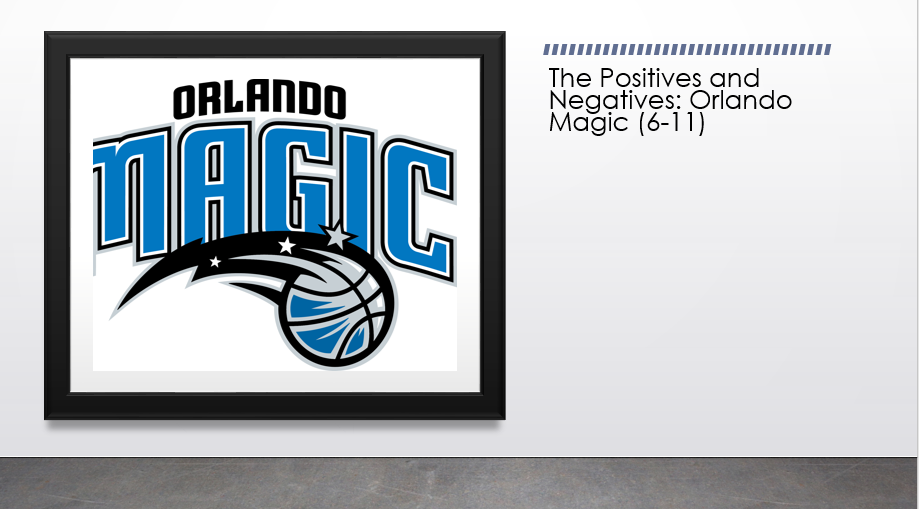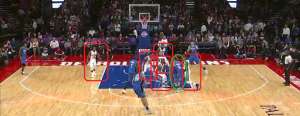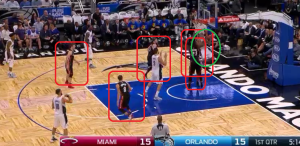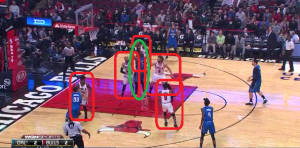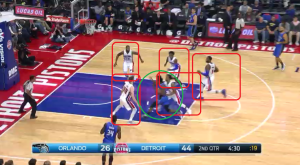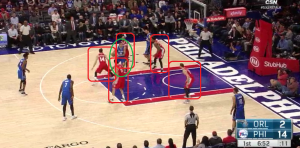Prior to the start of the NBA season, Vegas projected the Orlando Magic to finish 11th in the Eastern Conference with an over/under of 37.5 wins. Through 17 games together, with a new head coach and the addition of four new core players into their system, the Magic are on pace for just 28.9 wins this season, as they’ve stumbled out to a 6-11 start.
In trading for Serge Ibaka and then signing Bismack Biyombo to a four-year, $72-million-dollar deal, one might have expected the Magic to be one of the top defensive teams in the league, and those expectations are on par thus far. However, it’s the offense and skill sets of some of the players that have really held the Magic back from using their defensive capabilities to win more ball games.
Using some data and observations of watching film on the Magic, it’s time to take a deep dive into what they’re doing really well on each side of the floor, and where they might need drastic improvement as the season continues to zoom along.
The Positives on Offense
Grabbing extra boards – The Magic currently rank 9th in offensive rebounds per game with 11.1 extra boards. With extra possessions, they’re able to help produce second chance points, as Orlando is scoring 13.9 points in that department (ranked 11th in the NBA). One player who is doing a decent job of getting extra possessions for his team is Aaron Gordon (1.2 offensive rebounds per game). We’ll dive into this further, but this season, Gordon has mainly had to play out on the wing at the small forward positon. While spacing-wise he’s not benefiting his team because he’s not a threat from the outside, he is crashing the glass and staying active when his teammates miss. While the offensive boards can be painted as a positive, it is important to note that one of the reasons the Magic get extra possessions is because they’re the worst shooting team in the league.
Fournier’s shooting off the ball from right wing three – While 3-point shooting is not a strength for the Magic, Fournier should still get a mention for his early consistency in being a threat from the outside, as he’s taking 5.6 triples per game and knocking down 35.4% of those looks (above league average). From the right wing especially, Fournier has made 11-of-27 threes from that area (40.7%), which is 5.3% above the league average. As you’ll see in the clip below, credit goes to Fournier in how he’s able to be a dangerous off-the-ball shooter whether it’s coming off one or two screens from one side of the court to the other, how he can make threes off dribble hand-offs with little daylight, or even, how he can sometimes fake defenders without the ball in his hands to get loose for an open triple.
[protected-iframe id=”13298b59f30278fe7ddfe73e506b950d-114320562-25928832″ info=”https://streamable.com/e/pt0d” width=”560″ height=”278″ frameborder=”0″ scrolling=”no”]The Positives on Defense
Swatting shots –The Magic are swatting 5.8 shots per game, best for 7th in the league. Ibaka (1.7 blocks) and Biyombo (1.6 blocks) are each forces near the rim, as teams are getting denied at least once and almost twice per game by the duo. Despite the Magic swatting shots though, teams are still penetrating the lane and attacking the restricted area 28.5 times per game and shooting league average in that area (60.5%).
Keeping opponents off the free throw line – As a whole defensively, the Magic rank 10th in Defensive Efficiency in holding teams to 102.2 points per 100 possessions. One reason why the Magic are able to maintain a quality defensive team is because they do something really good defenses do – keep opponents off the free throw line. The Magic foul opponents just 17.6 times per game (ranked 5th best) and they only send teams to the line 19.4 times per game (ranked 5th best).
Limiting threes from other teams – Along with keeping teams off the free throw line, the Magic do a solid job as well of limiting opponent 3-pointers each night. Teams shoot just 23.5 threes against the Magic (ranked 5th lowest) and they are only making 33.3% of those looks (ranked 4th lowest). When dissecting the shot location of their opponents, teams are only taking 5.6 threes from the corners against the Magic (ranked 6th lowest) and making just 34.7% of them (ranked 6th lowest as well). That’s pretty good to limit one of the more efficient 3-point shots for NBA teams. When it comes to the above the break threes, the Magic hold teams to just 17.8 of those looks (ranked 5th lowest) and teams aren’t shooting a good percentage from there either (33.0% – ranked 9th lowest).
Another area where the Magic are doing a pretty good job on the defensive end is in forcing teams to have to settle for mid-range shots (21.2 attempts, ranked 5th lowest). Teams are shooting just above league average on mid-range jumpers (38.5%, ranked 13th), but in the era of spacing the floor and seeking threes or layups on offense, to make teams settle for a non-paint two is usually a good outcome defensively.
The Negatives on Offense
Shooting as a whole – Offensively, this is the area where the Magic will need their most improvement to prevent winning just 29 games this season. Orlando ranks last in Offensive Efficiency (95.4 PP/100) and their shooting from most areas of the floor is a key reason why their offense struggles so much. Let’s start from outside-in. The Magic are just below league average in generating 3-pointers (25.1 attempts, ranked 18th) and when they do take threes, they’re the worst in the league at making them, with a shooting percentage of 31.4% from beyond the arc.
When looking at their core players, the Magic have eight players on their roster who take over one three-pointer per game. Of those eight players, only three of them are shooting above league average from three right now (Fournier, Ibaka and Damjan Rudez when he plays in games). That means that five of the other Magic core players are non-threats to opposing defenses, which allows them to help and collapse the paint whether someone is driving or trying to work out of the low-post. The images below show the defenders (in red) around the player with the ball (in green) just before he attempts his shot attempt. Some of the images are taken from the halfcourt offense and in transition. The one common factor in each photo – the defense is collapsing on the ball and leaving most of the Magic offensive players on the arc wide open.
Having such limited floor spacing creates a domino effect for the rest of the Magic offense. Running pick and rolls becomes difficult because help defenders can collapse the lane. When there’s a post-up advantage, defenses can choose to either bring extra help with little consequence or even just play man-to-man defense on the post-up. As a team, the Magic shoot 40.9% from the floor (ranked last in the league). It’s not just the 3-point area, as the Magic rank 19th to 29th in shooting percentage from other areas of the floor like the restricted area, non-restricted area and mid-range.
When watching film of the Magic, it looks like they like to run motion sets on offense, and their pace (96.6 possessions per 48 minutes, ranked 24th) supports this style. When it comes to getting points from the interior or the free throw line, those areas are difficult to find points in because of the lack of shooting presence from the outside. The Magic score 39.9 points in the paint (ranked 25th) and visit the free throw line 20.4 times per game (ranked 25th), while knocking down 71.7% of their free throws (ranked 28th) and they don’t draw many fouls (18.7 personal fouls drawn, ranked 27th).
The Magic have a very balanced system, with many of their core players having a responsibility in their offense, as the usage percentages show below:
Fournier – 23.5%
Nikola Vucevic – 23.2%
D.J. Augustin – 23.1%
Ibaka – 21.6%
Elfrid Payton – 20.3%
Gordon – 19.8%
Jeff Green – 18.8%
Biyombo – 12.3%
(others – Mario Hezonja – 25.4%, C.J. Watson – 10.5%)
To his credit, by viewing their changing lineups with both the starters and bench, Head Coach Frank Vogel has been tinkering with different lineups and since it’s not even 20 games into the season, now in November might be the best time to be in the lab experimenting to find what works best before the season starts getting too far away. In just looking at their starting lineups, Vogel has tried two different lineups centered around switching the small forwards:
158 minutes – Payton, Fournier, Gordon, Ibaka, Vucevic: Offense 103.4 PP/100 – Defense 110.0 PP/100 = Net Rating of -6.6 PP/100
140 minutes – Payton, Fournier, Green, Ibaka, Vucevic: Offense 89.4 PP/100 – Defense 85.6 PP/100 = Net Rating of +3.8 PP/100
The Negatives on Defense
Opponent points in paint – As mentioned earlier, though the Magic do swat a lot of shots, teams are still getting into the paint and scoring (44.5 points in the paint per game, ranked 20th) on their defense. Overall though, the Magic are headed in the right direction defensively to have a Top-10 unit early in the season.
The real question going forward as the 20-game mark (1/4 of the season) approaches soon will be how the Magic start to generate more points on offense. Is it increasing the tempo to allow more run-and-gun attacks toward the rim, which would lead to some sacrifice on the defensive end? Or, is it continuing to work with the different lineups and possibly even moving Gordon back to the 4? For now, the Magic can try to stay within games due to the strength of their defense, but until they start to figure out their issues on offense (whether with this roster or moves later in the year), games will likely continue to get away from them.
Stats gathered from NBA.com/stats
Add The Sports Daily to your Google News Feed!
